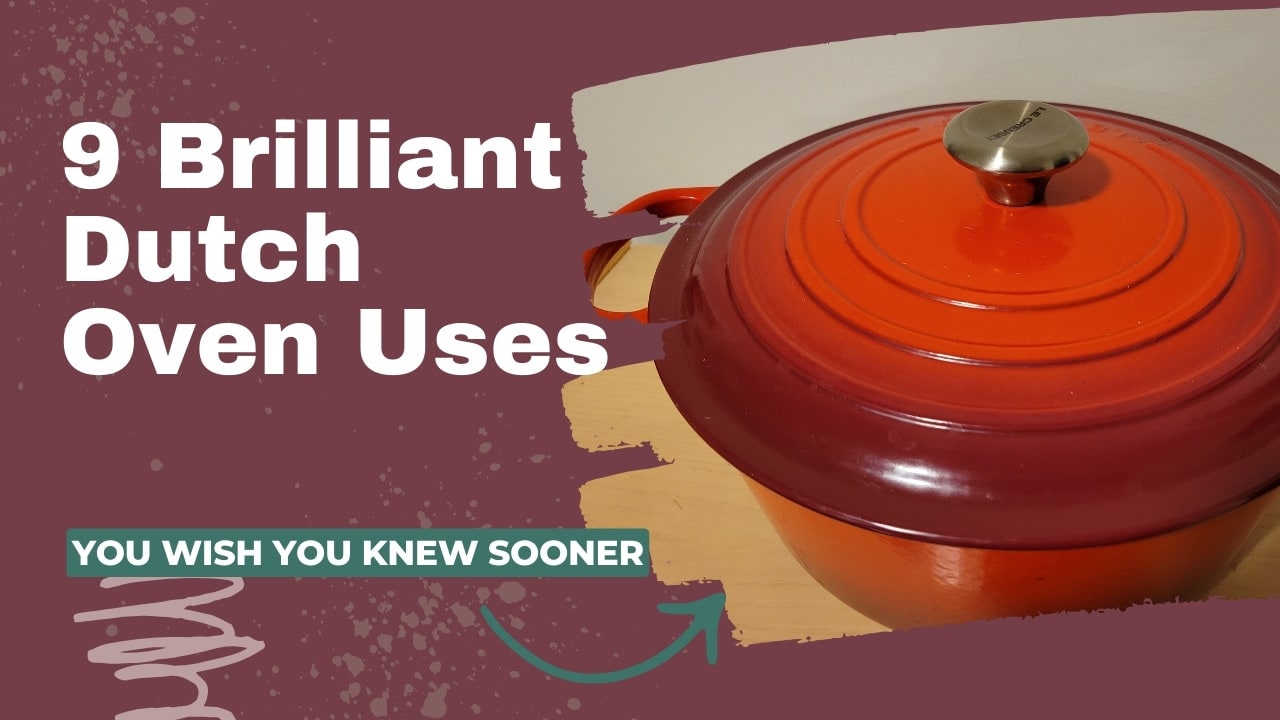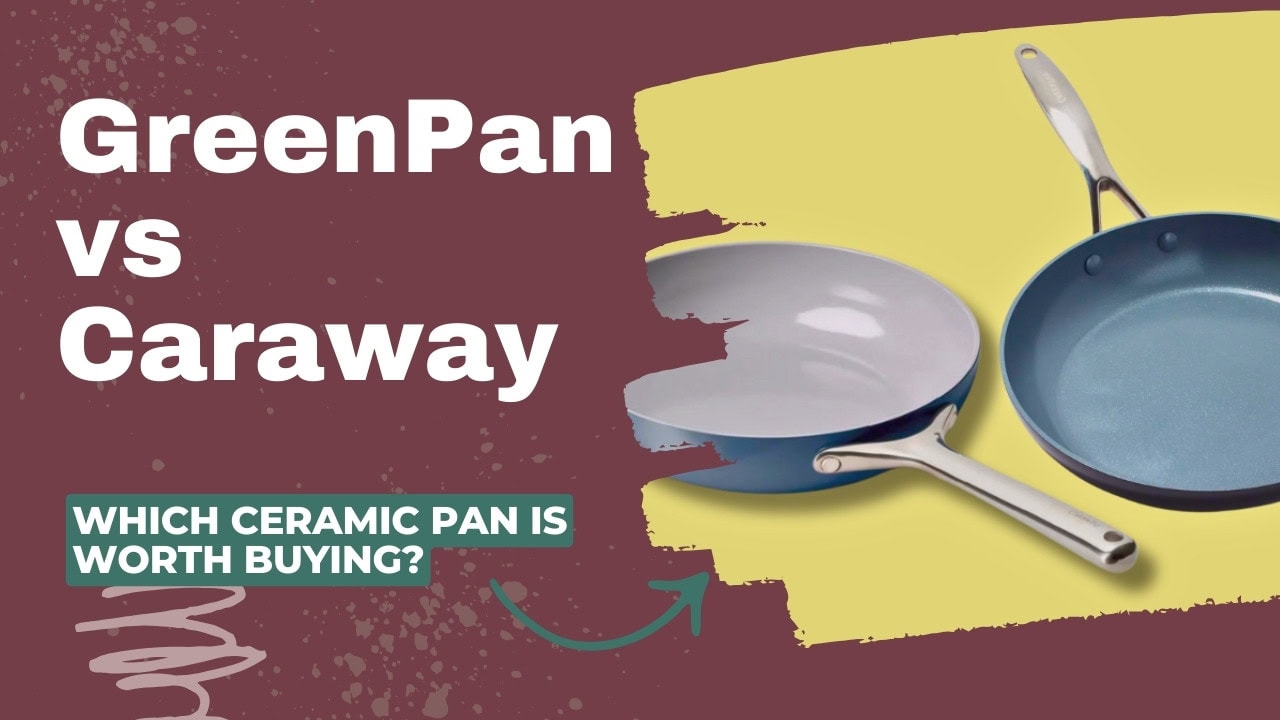I recently read a confession from a chef saying, ‘I don’t think I can function without my Dutch oven.’ And after a quick glance at my countertop, I knew that I was part of that club.
While it might not look much different from any other clunky pot, its sheer versatility and surprising cooking efficiency make a Dutch oven a must-have in any kitchen.
In this article, I’ll share the top 9 Dutch oven uses that go beyond the basic soups and stews.
What Are Dutch Ovens Good For?
Dutch ovens are great for slow cooking, baking, frying, poaching, roasting, making soups, and even desserts. Their thick walls and tight-fitting lids distribute heat evenly, making them perfect for recipes that require long, gentle cooking.
A Dutch oven can also double as a storage vessel for leftovers — cool it down, snap on a lid, and put it straight into the fridge.
9 Amazing Uses for Dutch Ovens
There’s virtually nothing that you can’t cook in a Dutch oven. What truly sets these pots apart is that you can start a dish by sautéing or searing ingredients on the stovetop, then effortlessly transition to slow cooking or roasting in the oven without changing pots.
Once your dish is done, the same pot can be used for serving your culinary masterpiece. Following are some of the ways to use a Dutch oven:
1. Cooking One Pot Meals
If there is one thing a Dutch oven excels at, it is, of course, cooking one-pot meals. One-pot meals are a lifesaver for busy cooks. There’s nothing more convenient than being able to dump all your ingredients into one pot, let it simmer away, and have a complete, delicious meal ready with minimal cleanup.
The thick walls of a cast-iron Dutch oven retain heat well and distribute it evenly, making them ideal for preparing hearty stews, chili, casseroles, and other one-dish wonders.
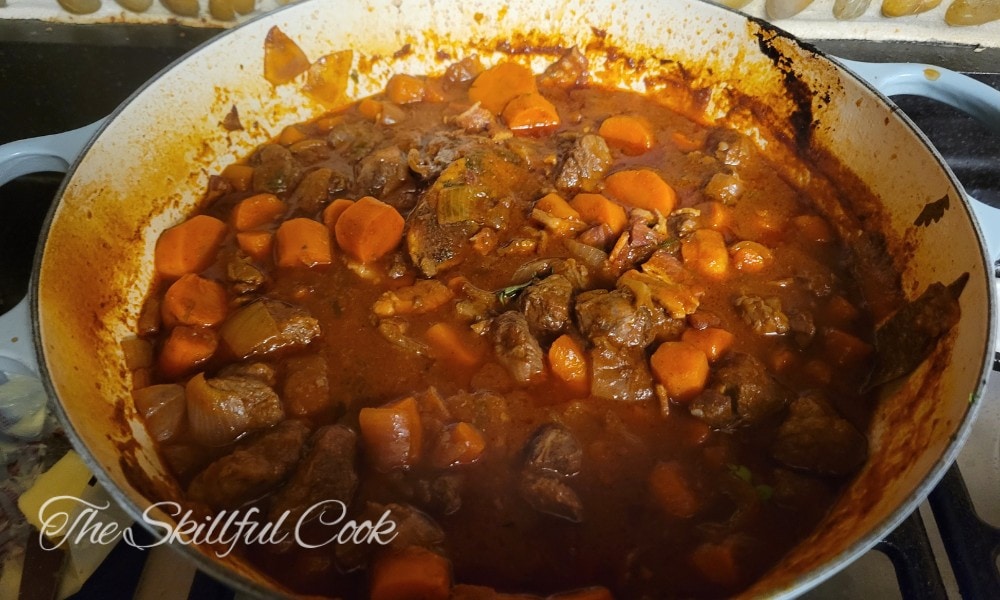
For weeknight one-pot meals, a 5-6 quart Dutch oven is perfect. This mid-sized pot can handle a 4-pound chicken while still leaving enough room for veggies like potatoes and carrots. If your recipe calls for acidic ingredients like tomatoes, opt for an enameled cast iron Dutch oven.
2. Braising Meat and Vegetables
If you feel like your meats are lacking that succulent, fall-off-the-bone quality after simmering, try braising them in a Dutch oven with a tight-fitting lid. Some Dutch ovens, like the Staub Cocotte, feature bumps on the underside of the lid that drive moisture back into the meat in the pot.
The result? A slow, even cook that will make your braised meat and veggies incredibly tender.
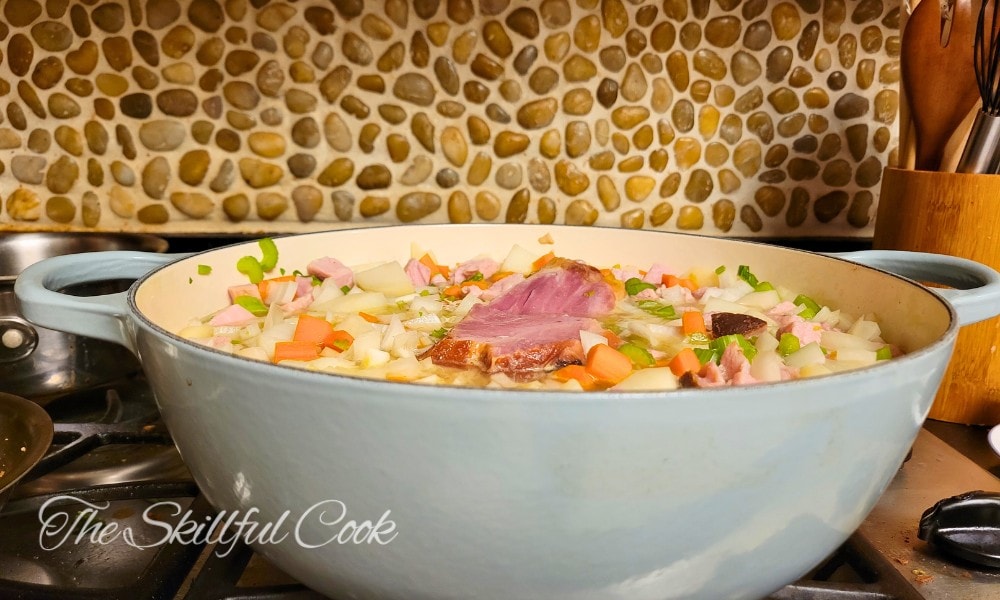
You can try braising different types of meat, like beef chuck roast, pork shoulder, lamb shanks, or chicken thighs. Cook everything from a beef bourguignon or osso buco to my personal favorite — Crispy Milk-Braised Pork Belly.
3. Making Hearty Soups
Dutch ovens excel at cooking soups low and slow, due to their ability to heat evenly and maintain a consistent temperature. The even heat distribution can help prevent scalding or scorching – though high-quality Dutch ovens like Le Creuset do a better job at this than cheaper dupes. Its lid holds in moisture, allowing soups to simmer languidly without drying out.
Some delicious soups and stews you can try in a Dutch oven are chicken noodle soup, pork and hominy posole, creamy tomato basil soup, spicy Thai coconut soup, smoky split pea soup, and Broccoli Soup.
When using a Dutch oven for cooking soups, leave a little room at the top to avoid splatters while stirring. And if your soup includes grains or pasta, add them in the last minutes of cooking. This prevents them from turning into mush.
4. Roasting
Who doesn’t love succulent roasts that just melt in your mouth? However, if you have ever tried making a roast in a standard pot or over a campfire, you know how challenging it can be.
Roasting meat and vegetables in a Dutch oven is a breeze thanks to its thick, heavy walls that radiate and distribute heat evenly. This means no more worrying about undercooked middles or burnt edges.
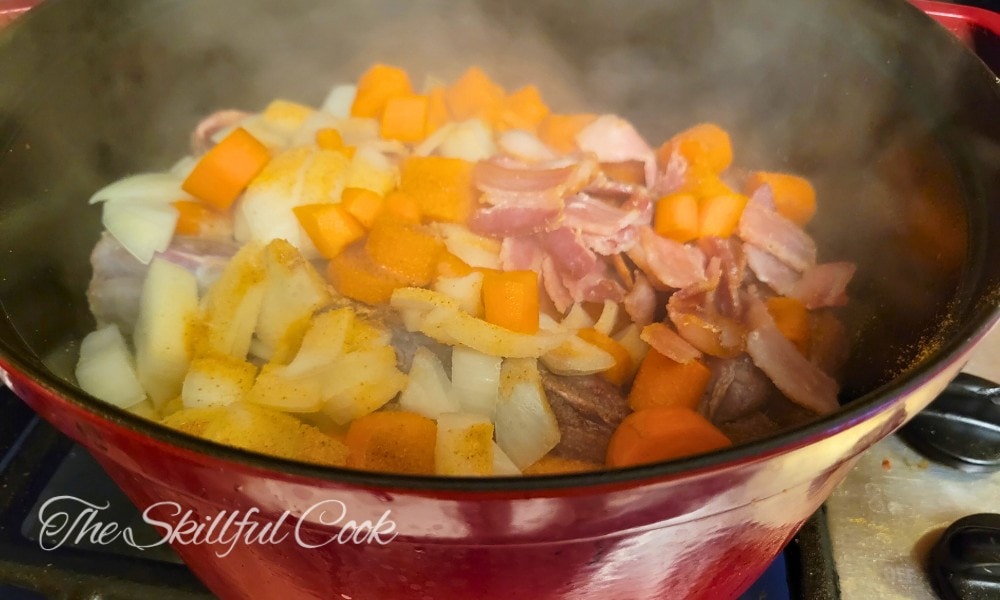
Whenever making a roast, I always cover the pot with a lid, so my roast doesn’t dry out. If you find this steams the meat too much, you can broil it for a few minutes at the end of cooking to create a crust on the exterior. Just make sure your Dutch oven is rated for 500°F or more!
If you plan on searing your meat before transferring it to the oven, I recommend using a cast iron Dutch oven like the Amazon Basics Pre-Seasoned Cast Iron Round Dutch Oven. Cast Iron cookware can withstand high heat so you can get an irresistible crust.
5. Frying and Deep-frying Food
If you love munching on fried food but hate pulling out your deep fryer every time you get a craving, consider using your Dutch oven for all your frying needs.
Again, a Dutch oven’s exceptional heat retention means that once hot, Dutch ovens can maintain a consistent temperature even when you’re adding cold items.
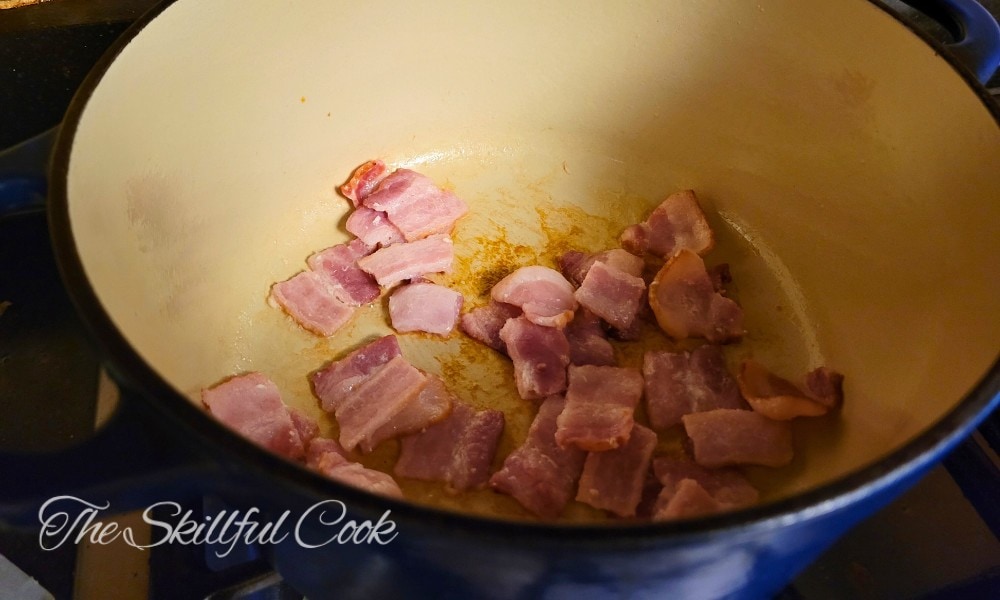
The deep design of a Dutch oven minimizes splatter as you add food and allows you to fry larger batches of food without overcrowding. This can help avoid soggy or overly greasy results.
As for the size, I like to use my 6.75 qt oval Dutch oven for frying foods like french fries or doughnuts. The oval shape lets me cook more items at a time compared to a round pot. Just make sure to use enough oil – you’ll want at least 2-3 inches for deep frying.
Some great fried recipes I have successfully tried making in a Dutch oven include buttermilk fried chicken, crispy french fries, fried shrimp, funnel cake, fritters, tempura, Oliebollen (deep-fried dough balls), beignets, fried calamari, and churros.
6. Simmering Sauces and Gravies
Dutch ovens can also be used for making those delectable, silky sauces and heartwarming gravies that turn a good meal into a great one. These pots resist sudden temperature spikes that can cause part of your sauce to burn while the rest is barely bubbling.
Since gravies require low to medium heat, non-stick Dutch ovens are worth considering. These ovens feature a slick surface of Teflon or ceramic that prevents food from sticking to the bottom.
From classic beef gravy to citrusy piccata sauce, tomato basil sauce, mushroom gravy, and creamy alfredo sauce, there’s a lot you can make using your Dutch oven.
7. Baking Breads, Cakes and Desserts
If you’re a pastry chef or a baking enthusiast eager to experiment, purchasing a top-quality cast iron Dutch oven can transform your creations. It mimics a steam-injection oven, creating the ideal environment for moist, dense cakes to loaves with great oven spring.
The semi-non-stick interior prevents dough from sticking to the walls while its high-temperature resistance of 500 degrees Fahrenheit makes it perfect for baking bread.
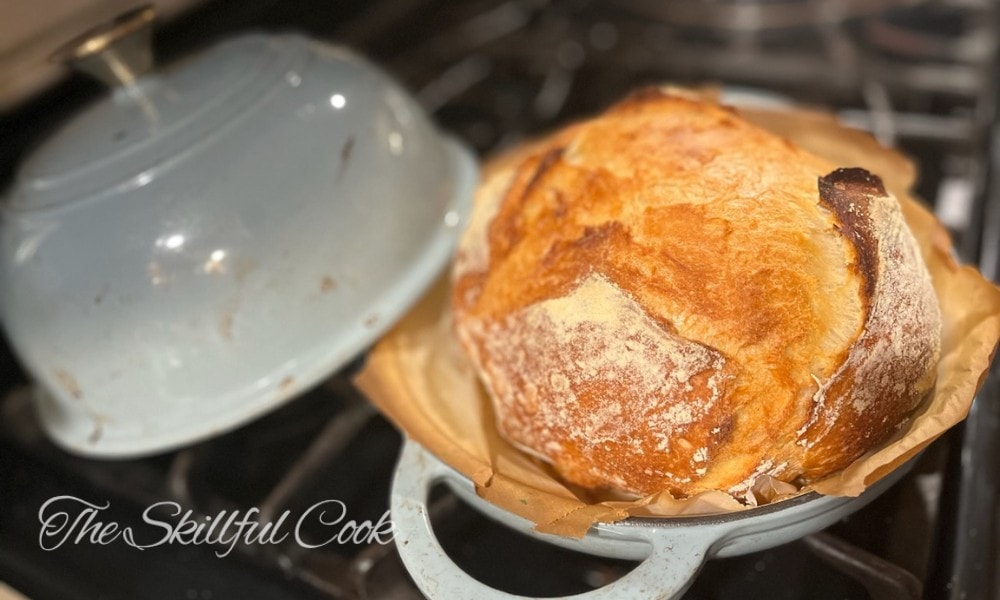
Courtesy of its perfectly round shape, you can use your Dutch oven to make boules, no-knead artisan-style bread, or sourdough with a crackly crust and soft, airy insides.
The size of the Dutch oven plays an important role in the outcome of your bread. If it’s too small, your bread may not rise to its full potential. On the other hand, cooking with a Dutch oven that’s too big can cause your bread to flatten out more than you’d like. Ideally, a 5-6 quart Dutch oven is the perfect size for most bread recipes with good oven spring.
Dutch ovens can also be used to whip up some heavenly cakes and scrumptious desserts like good ol’ chocolate cake, apple cobbler, cinnamon rolls, peach cake, and berry cobbler.
8. Food Serving and Storage
Dutch ovens are kitchen all-rounders that can be used for cooking, serving and even storing any leftover food. They are available in classic colors so you can transfer the pot straight to a pot holder on the table to serve. My favorite is this gorgeous ceramic Dutch oven from Emily Henry.
This cookware also keeps your dishes warm for longer, ensuring second (or third!) servings are just as enjoyable as the first.
Once you’re done eating, you can simply slide the lid on your Dutch oven and pop it in the fridge without transferring your leftover food to other storage containers. This minimizes kitchen clutter and saves you from scrubbing another dish.
If storing leftovers in the Dutch oven in the fridge, allow the food to cool down to room temperature first to prevent thermal shock, especially if it has an enamel or ceramic coating. When taking it out of the fridge, allow it to come to temperature slowly before putting it on the stove or oven, for the same reason.
9. Reheating Leftovers
Have you ever tried reheating leftover pasta or a half-eaten casserole in a microwave only to end up with a not-so-appetizing meal?
If you want your leftovers to taste and feel just as good as the first time around, try reheating them in a Dutch oven instead. The thick cast iron walls of your Dutch oven can help distribute heat steadily. So you don’t have to worry about your leftovers getting overcooked or developing that rubbery texture. I find that cold leftovers heat much faster, but without burning, in a Dutch oven than in, say, an uncovered glass pan.
Consider adding a small amount of liquid — think water, stock, or milk — to restore the food to its original consistency. This can stop the leftovers from drying out.
Frequently Asked Questions
What’s the point of a Dutch oven?
A Dutch oven is a versatile, heavy cooking pot that can be used for braising, stewing, simmering, boiling and even storing leftovers. Its incredible heat retention and high-temperature resistance make it oven-safe — perfect for making baked goods.
If you have a well-seasoned cast iron camp Dutch oven from Lodge brand, you can even make campfire classics.
What should you not cook in a Dutch oven?
If you own a natural cast iron Dutch oven, you should avoid using it for cooking highly acidic foods that may react with the metal, leading to a metallic taste in your food and potentially damaging the pot’s seasoning.
If you plan on cooking acidic foods in your Dutch oven, consider buying an enameled Dutch oven, like the reliable and affordable Lodge.
Do you really need a Dutch oven?
While not essential, a Dutch oven has many uses and is a great addition to your kitchen arsenal. Thanks to its versatile nature, Dutch ovens minimize the need for using pots and pans while streamlining the whole cooking process.
Since most types of Dutch ovens have a heavy build, they can last for generations if handled properly.
The Takeaway
Dutch ovens are so versatile that owning one could reduce your need for keeping multiple other pots and pans. The Staub Cocotte is a great example of a single pot with many many uses. With this one piece of cookware, you can whip up anything from hearty stews to homemade bread that may rival the local bakery’s.
Still curious about how to slow-cook a perfect pot roast? Or need help with a Cordon Bleu Dutch oven recipe? Drop your thoughts and questions in the comment section below. We’re super excited to hear what you’re cooking up!

